Engine MITSUBISHI MIRAGE G4 2020 Owner's Manual (in English)
[x] Cancel search | Manufacturer: MITSUBISHI, Model Year: 2020, Model line: MIRAGE G4, Model: MITSUBISHI MIRAGE G4 2020Pages: 253, PDF Size: 36.39 MB
Page 224 of 253
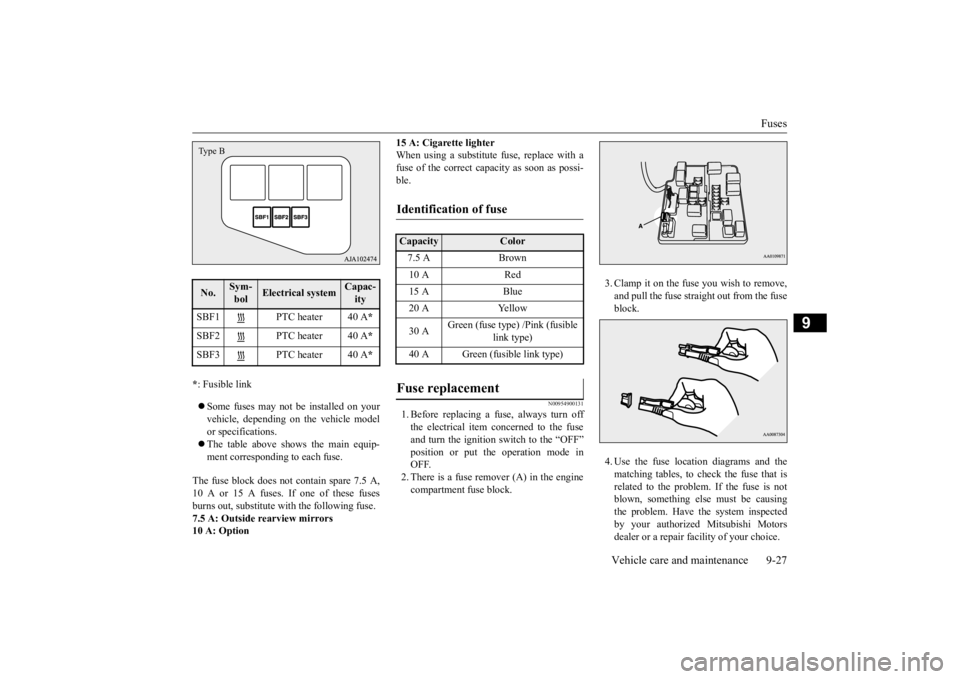
Fuses
Vehicle care and maintenance 9-27
9
* : Fusible link Some fuses may not be installed on your vehicle, depending on
the vehicle model
or specifications. The table above show
s the main equip-
ment corresponding to each fuse.
The fuse block does not contain spare 7.5 A, 10 A or 15 A fuses. If one of these fuses burns out, substitute with the following fuse. 7.5 A: Outside rearview mirrors10 A: Option
15 A: Cigarette lighter When using a substitute fuse, replace with afuse of the correct capacity as soon as possi- ble.
N00954900131
1. Before replacing a fuse, always turn off the electrical item concerned to the fuseand turn the ignition switch to the “OFF” position or put th
e operation mode in
OFF.2. There is a fuse remover (A) in the engine compartment fuse block.
3. Clamp it on the fuse you wish to remove, and pull the fuse straight out from the fuseblock. 4. Use the fuse location diagrams and the matching tables, to check the fuse that is related to the problem. If the fuse is notblown, something else must be causing the problem. Have the system inspected by your authorized Mitsubishi Motors dealer or a repair facility of your choice.
No.
Sym- bol
Electrical system
Capac-ity
SBF1 PTC heater 40 A
*
SBF2 PTC heater 40 A
*
SBF3 PTC heater 40 A
*
Type B
Identification of fuse Capacity
Color
7.5 A Brown 10 A Red 15 A Blue 20 A Yellow 30 A
Green (fuse type) /Pink (fusible
link type)
40 A Green (fusible link type)
Fuse replacement
BK0284300US.book 27 ページ 2019年5月23日 木曜日 午後12時22分
Page 233 of 253
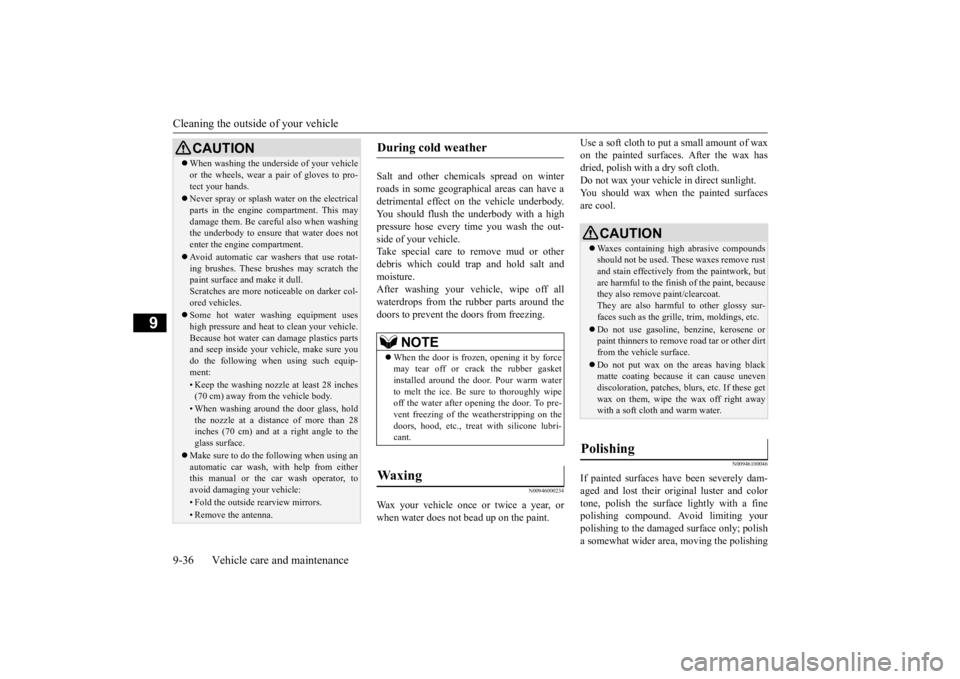
Cleaning the outside of your vehicle 9-36 Vehicle care and maintenance
9
Salt and other chemical
s spread on winter
roads in some geographical areas can have a detrimental effect on the vehicle underbody.You should flush the underbody with a high pressure hose every time you wash the out- side of your vehicle.Take special care to remove mud or other debris which could trap and hold salt and moisture. After washing your vehicle, wipe off all waterdrops from the rubber parts around thedoors to prevent the doors from freezing.
N00946000234
Wax your vehicle once or twice a year, orwhen water does not
bead up on the paint.
Use a soft cloth to put a small amount of wax on the painted surfaces.
After the wax has
dried, polish with
a dry soft cloth.
Do not wax your vehicle in direct sunlight. You should wax when the painted surfacesare cool.
N00946100046
If painted surfaces have
been severely dam-
aged and lost their original luster and color tone, polish the surface
lightly with a fine
polishing compound. Avoid limiting your polishing to the damage
d surface only; polish
a somewhat wider area, moving the polishing
CAUTION When washing the underside of your vehicle or the wheels, wear a pair of gloves to pro-tect your hands. Never spray or splash water on the electrical parts in the engine compartment. This maydamage them. Be careful also when washing the underbody to ensure that water does not enter the engine compartment. Avoid automatic car washers that use rotat- ing brushes. These br
ushes may scratch the
paint surface a
nd make it dull.
Scratches are more not
iceable on darker col-
ored vehicles. Some hot water wash
ing equipment uses
high pressure and heat
to clean your vehicle.
Because hot water can da
mage plastics parts
and seep inside your ve
hicle, make sure you
do the following when using such equip-ment:• Keep the washing nozzle at least 28 inches(70 cm) away from the vehicle body.• When washing around the door glass, holdthe nozzle at a distance of more than 28 inches (70 cm) and at a right angle to the glass surface.
Make sure to do the following when using an automatic car wash, with help from eitherthis manual or the car wash operator, to avoid damaging your vehicle:• Fold the outside
rearview mirrors.
• Remove the antenna.
During cold weather
NOTE
When the door is frozen, opening it by force may tear off or crack the rubber gasket installed around the door. Pour warm water to melt the ice. Be
sure to thoroughly wipe
off the water after opening the door. To pre- vent freezing of the
weatherstripping on the
doors, hood, etc., treat
with silicone lubri-
cant.
Waxing
CAUTION Waxes containing high abrasive compounds should not be used. Th
ese waxes remove rust
and stain effectively fr
om the paintwork, but
are harmful to the finish of the paint, because they also remove
paint/clearcoat.
They are also harmful to other glossy sur- faces such as the grille, trim, moldings, etc. Do not use gasoline, benzine, kerosene or paint thinners to remove
road tar or other dirt
from the vehicle surface. Do not put wax on the areas having black matte coating because
it can cause uneven
discoloration, patches, bl
urs, etc. If these get
wax on them, wipe the wax off right away with a soft clot
h and warm water.
Polishing
BK0284300US.book 36 ページ 2019年5月23日 木曜日 午後12時22分
Page 234 of 253
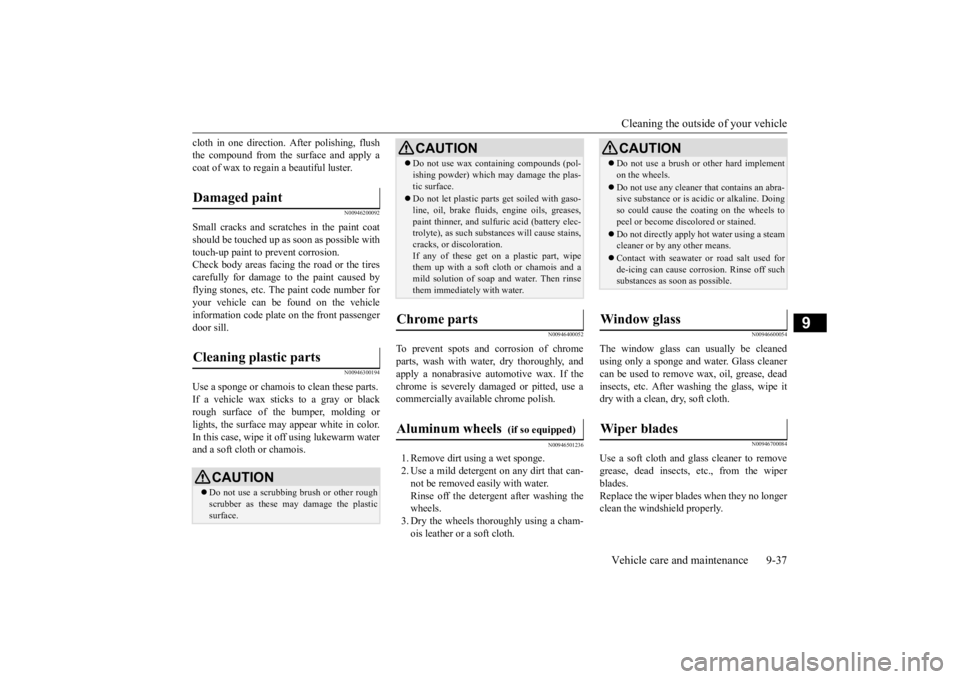
Cleaning the outside of your vehicle Vehicle care and maintenance 9-37
9
cloth in one direction.
After polishing, flush
the compound from the surface and apply acoat of wax to regain a beautiful luster.
N00946200092
Small cracks and scratches in the paint coatshould be touched up as
soon as possible with
touch-up paint to prevent corrosion. Check body areas facing the road or the tires carefully for damage to the paint caused by flying stones, etc. The
paint code number for
your vehicle can be found on the vehicle information code plat
e on the front passenger
door sill.
N00946300194
Use a sponge or chamois to clean these parts.If a vehicle wax sticks to a gray or blackrough surface of the bumper, molding or lights, the surface may appear white in color. In this case, wipe it
off using lukewarm water
and a soft cloth or chamois.
N00946400052
To prevent spots and corrosion of chromeparts, wash with water, dry thoroughly, andapply a nonabrasive automotive wax. If the chrome is severely da
maged or pitted, use a
commercially available chrome polish.
N00946501236
1. Remove dirt using a wet sponge.2. Use a mild detergent on any dirt that can-not be removed ea
sily with water.
Rinse off the detergent after washing the wheels.3. Dry the wheels thoroughly using a cham- ois leather or a soft cloth.
N00946600054
The window glass can
usually be cleaned
using only a sponge and
water. Glass cleaner
can be used to remove
wax, oil, grease, dead
insects, etc. After washing the glass, wipe it dry with a clean, dry, soft cloth.
N00946700084
Use a soft cloth and gl
ass cleaner to remove
grease, dead insects, etc., from the wiperblades. Replace the wiper blades when they no longer clean the windshield properly.
Damaged paint Cleaning plastic parts
CAUTION Do not use a scrubbing brush or other rough scrubber as these may
damage the plastic
surface.
Do not use wax containing compounds (pol- ishing powder) which ma
y damage the plas-
tic surface. Do not let plastic parts get soiled with gaso- line, oil, brake fluids
, engine oils, greases,
paint thinner, and sulfur
ic acid (battery elec-
trolyte), as such substa
nces will cause stains,
cracks, or discoloration.If any of these get on a plastic part, wipe them up with a soft cloth or chamois and a mild solution of soap and water. Then rinsethem immediately with water.
Chrome parts Aluminum wheels
(if so equipped)
CAUTION
CAUTION Do not use a brush or
other hard implement
on the wheels. Do not use any cleaner th
at contains an abra-
sive substance or is ac
idic or alkaline. Doing
so could cause the coating on the wheels topeel or become disc
olored or stained.
Do not directly apply
hot water using a steam
cleaner or by any other means. Contact with seawater or road salt used for de-icing can cause corr
osion. Rinse off such
substances as soon as possible.
Window glass Wiper blades
BK0284300US.book 37 ページ 2019年5月23日 木曜日 午後12時22分
Page 235 of 253

Cleaning the outside of your vehicle 9-38 Vehicle care and maintenance
9
N00947000071
Never spray or splash
water on the electrical
accessories in the engine compartment. This puts the engine at risk of being damaged.Do not bring the circum
ferential parts, the
plastic parts and so on
into contact with sulfu-
ric acid (battery electrolyte) which maycrack, stain or discolor them. If they are in contact, wipe off with soft cloth, chamois or the like and an aqueous solution of neutral detergent th
en immediately rinse
the affected parts with plenty of water.Engine compartment BK0284300US.book 38 ページ 2019年5月23日 木曜日 午後12時22分
Page 240 of 253
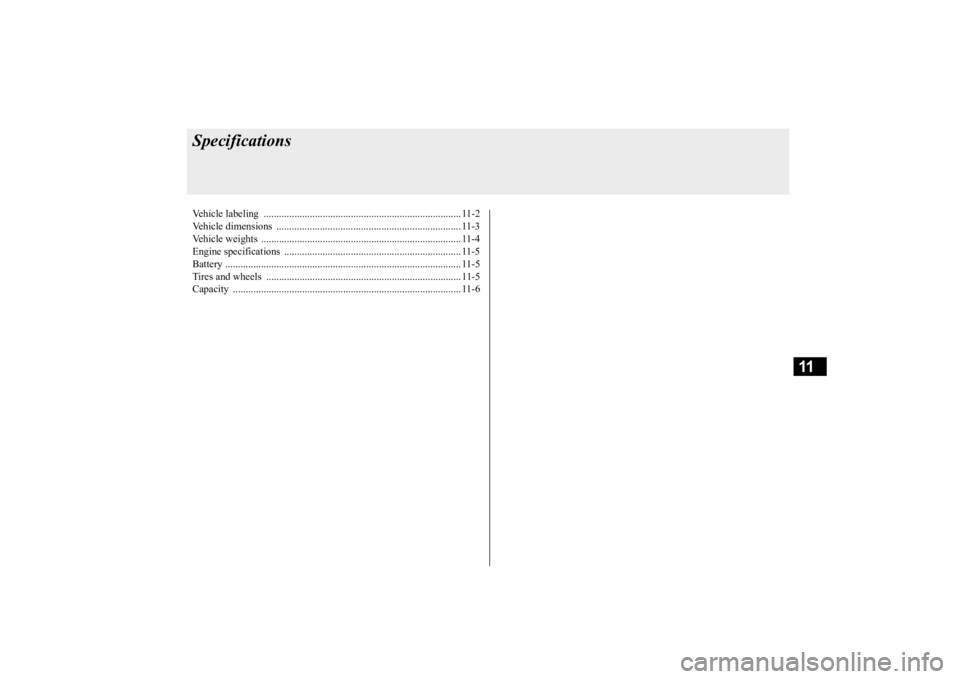
11
SpecificationsVehicle labeling ............................................................................. 11-2 Vehicle dimensions ........................................................................ 11-3 Vehicle weights .............................................................................. 11-4Engine specifications ..................................................................... 11-5 Battery ............................................................................................ 11-5 Tires and wheels ............................................................................ 11-5Capacity ......................................................................................... 11-6
BK0284300US.book 1 ページ 2019年5月23日 木曜日 午後12時22分
Page 241 of 253
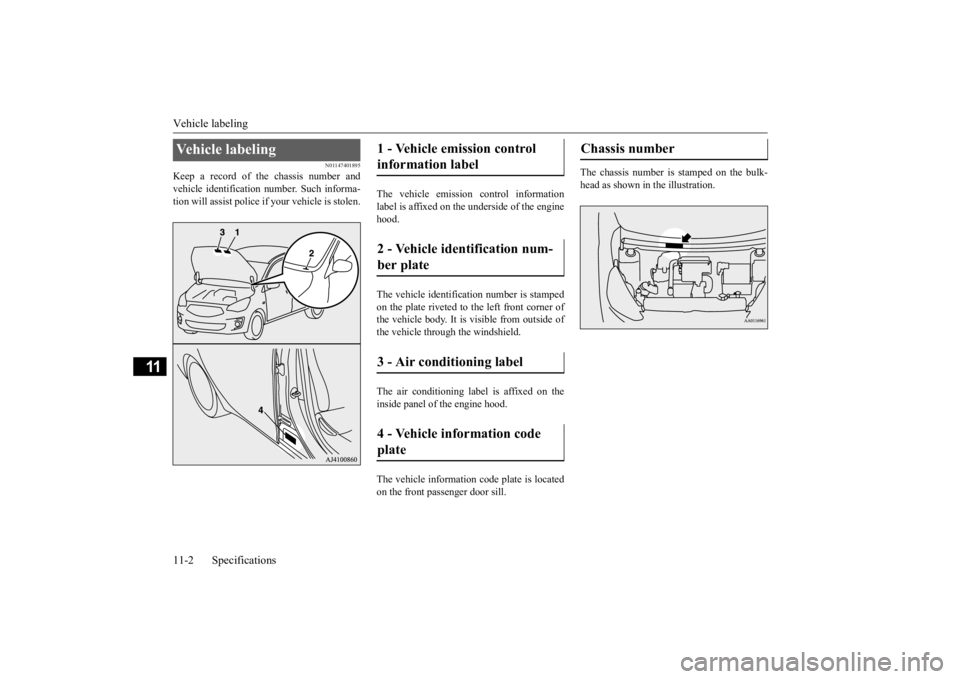
Vehicle labeling 11-2 Specifications
11
N01147401895
Keep a record of the chassis number and vehicle identification
number. Such informa-
tion will assist police if
your vehicle is stolen.
The vehicle emission
control information
label is affixed on the underside of the enginehood. The vehicle identificati
on number is stamped
on the plate riveted to the left front corner ofthe vehicle body. It is
visible from outside of
the vehicle through the windshield. The air conditioning label is affixed on the inside panel of the engine hood. The vehicle information code plate is located on the front passenger door sill.
The chassis number is stamped on the bulk- head as shown in the illustration.
Vehicle labeling
1 - Vehicle emission control information label 2 - Vehicle identification num- ber plate 3 - Air conditioning label 4 - Vehicle information code plate
Chassis number
BK0284300US.book 2 ページ 2019年5月23日 木曜日 午後12時22分
Page 242 of 253
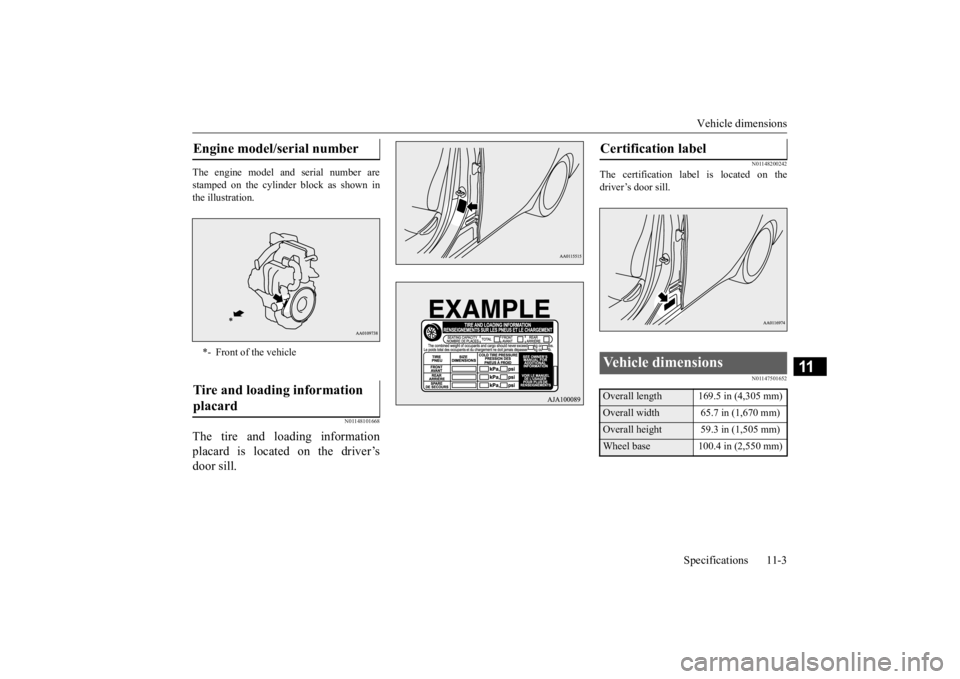
Vehicle dimensions
Specifications 11-3
11
The engine model a
nd serial number are
stamped on the cylinder block as shown in the illustration.
N01148101668
The tire and loading information placard is located on the driver’s door sill.
N01148200242
The certification label is located on the driver’s door sill.
N01147501652
Engine model/serial number *- Front of the vehicleTire and loading information placard
Certification label Vehicle dimensions Overall length 169.5 in (4,305 mm)Overall width 65.7 in (1,670 mm)Overall height 59.3 in (1,505 mm)Wheel base 100.4 in (2,550 mm)
BK0284300US.book 3 ページ 2019年5月23日 木曜日 午後12時22分
Page 244 of 253
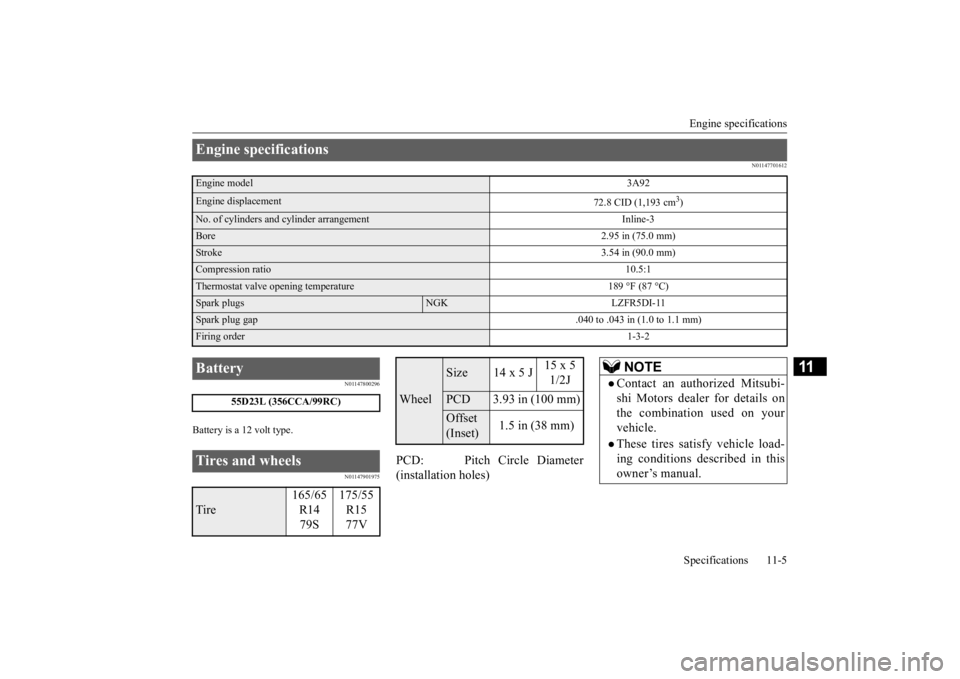
Engine specifications Specifications 11-5
11
N01147701612
N01147800296
Battery is a 12 volt type.
N01147901975
PCD: Pitch Circle Diameter (installation holes)
Engine specifications Engine model
3A92
Engine displacement
72.8 CID (1,193 cm
3)
No. of cylinders and cyli
nder arrangement Inline-3
Bore
2.95 in (75.0 mm)
Stroke
3.54 in (90.0 mm)
Compression ratio
10.5:1
Thermostat valve opening temperature 189 °F (87 °C)Spark plugs
NGK LZFR5DI-11
Spark plug gap .040 to .043 in (1.0 to 1.1 mm)Firing order
1-3-2
Battery
55D23L (356CCA/99RC)
Tires and wheels Tire
165/65 R14 79S
175/55 R15 77V
Wheel
Size 14 x 5 J
15 x 5 1/2J
PCD 3.93 in (100 mm)Offset (Inset)
1.5 in (38 mm)
NOTE
Contact an authorized Mitsubi- shi Motors dealer for details onthe combination used on your vehicle.These tires satisfy vehicle load-ing conditions d
escribed in this
owner’s manual.
BK0284300US.book 5 ページ 2019年5月23日 木曜日 午後12時22分
Page 245 of 253
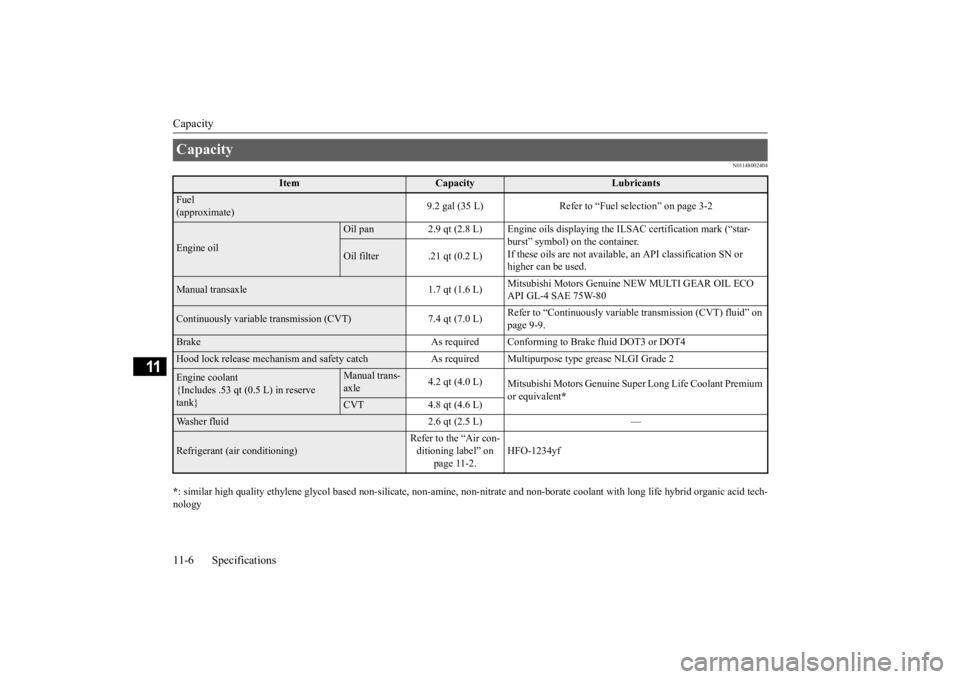
Capacity 11-6 Specifications
11
N01148002404
* : similar high quality ethylene
glycol based non-silicate, non-
amine, non-nitrate and non-borate
coolant with long life hybrid
organic acid tech-
nologyCapacity
Item
Capacity
Lubricants
Fuel (approximate)
9.2 gal (35 L) Refer to “Fue
l selection” on page 3-2
Engine oil
Oil pan 2.9 qt (2.8 L) Engine oils displa
ying the ILSAC certification mark (“star-
burst” symbol) on the container. If these oils are not available,
an API classification SN or
higher can be used.
Oil filter .21 qt (0.2 L)
Manual transaxle 1.7 qt (1.6 L)
Mitsubishi Motors Genuine
NEW MULTI GEAR OIL ECO
API GL-4 SAE 75W-80
Continuously variable transmission (CVT) 7.4 qt (7.0 L)
Refer to “Continuously variable
transmission (CVT) fluid” on
page 9-9.
Brake As required Conforming to Brake fluid DOT3 or DOT4Hood lock release mechanism and safety catch A
s required Multipurpose type
grease NLGI Grade 2
Engine coolant {Includes .53 qt (0.5 L) in reserve tank}
Manual trans- axle
4.2 qt (4.0 L)
Mitsubishi Motors Genuine Supe
r Long Life Coolant Premium
or equivalent
*
CVT 4.8 qt (4.6 L)
Washer fluid 2.6 qt (2.5 L) —Refrigerant (air conditioning)
Refer to the “Air con- ditioning label” on
page 11-2.
HFO-1234yf
BK0284300US.book 6 ページ 2019年5月23日 木曜日 午後12時22分
Page 246 of 253
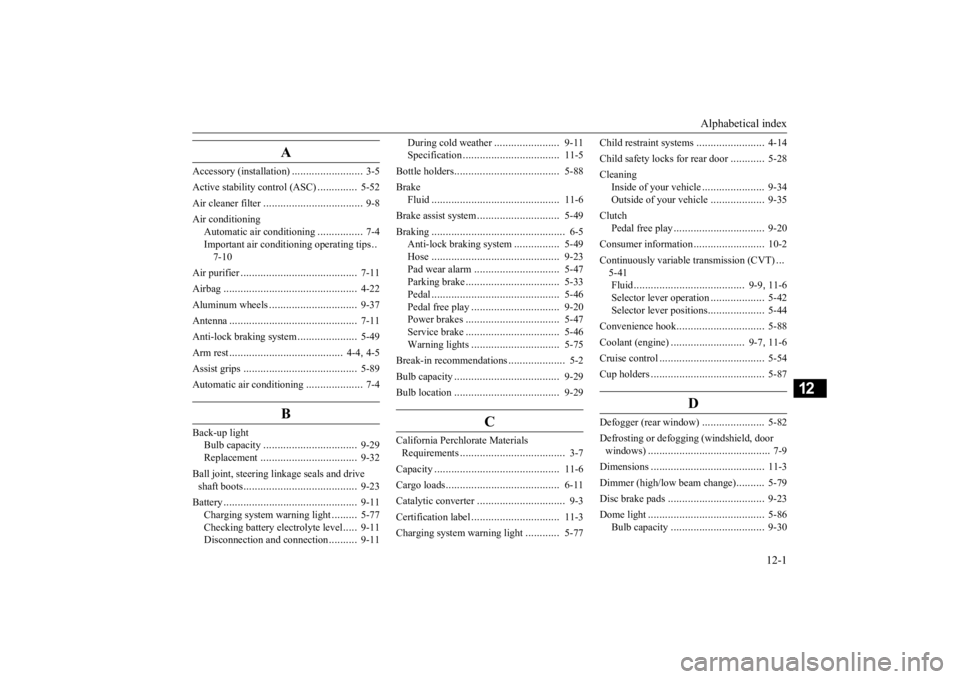
Alphabetical index
12-1
12
A
Accessory (installation)
.........................
3-5
Active stability control (ASC)
..............
5-52
Air cleaner filter
...................................
9-8
Air conditioning
Automatic air conditioning
................
7-4
Important air condi
tioning operating tips
..
7-10
Air purifier
.........................................
7-11
Airbag
...............................................
4-22
Aluminum wheels
...............................
9-37
Antenna
.............................................
7-11
Anti-lock braking system
.....................
5-49
Arm rest
........................................
4-4
, 4-5
Assist grips
........................................
5-89
Automatic air conditioning
....................
7-4
B
Back-up light
Bulb capacity
.................................
9-29
Replacement
..................................
9-32
Ball joint, steering li
nkage seals and drive
shaft boots
........................................
9-23
Battery
...............................................
9-11
Charging system warning light
.........
5-77
Checking battery el
ectrolyte level
.....
9-11
Disconnection and connection
..........
9-11
During cold weather
.......................
9-11
Specification
..................................
11-5
Bottle holders
.....................................
5-88
Brake
Fluid
.............................................
11-6
Brake assist system
.............................
5-49
Braking
...............................................
6-5
Anti-lock braking system
................
5-49
Hose
.............................................
9-23
Pad wear alarm
..............................
5-47
Parking brake
.................................
5-33
Pedal
.............................................
5-46
Pedal free play
...............................
9-20
Power brakes
.................................
5-47
Service brake
.................................
5-46
Warning lights
...............................
5-75
Break-in recommendations
....................
5-2
Bulb capacity
.....................................
9-29
Bulb location
.....................................
9-29
C
California Perchl
orate Materials
Requirements
.....................................
3-7
Capacity
............................................
11-6
Cargo loads
........................................
6-11
Catalytic converter
...............................
9-3
Certification label
...............................
11-3
Charging system warning light
............
5-77
Child restraint systems
........................
4-14
Child safety locks for rear door
............
5-28
Cleaning
Inside of your vehicle
......................
9-34
Outside of your vehicle
...................
9-35
Clutch
Pedal free play
................................
9-20
Consumer information
.........................
10-2
Continuously variable transmission (CVT)
...
5-41 Fluid
.......................................
9-9
, 11-6
Selector lever operation
...................
5-42
Selector lever positions
....................
5-44
Convenience hook
...............................
5-88
Coolant (engine)
..........................
9-7
, 11-6
Cruise control
.....................................
5-54
Cup holders
........................................
5-87
D
Defogger (rear window)
......................
5-82
Defrosting or defogging
(windshield, door
windows)
...........................................
7-9
Dimensions
........................................
11-3
Dimmer (high/low beam change)
..........
5-79
Disc brake pads
..................................
9-23
Dome light
.........................................
5-86
Bulb capacity
.................................
9-30
BK0284300US.book 1 ページ 2019年5月23日 木曜日 午後12時22分